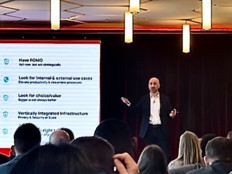Remote Work Will Continue After the Pandemic
The changes organizations have made to continue operations under shelter-in-place orders are likely to shift the way they conduct business even after restrictions are lifted, according to Cisco Live speakers. WakeMed Health & Hospitals in Raleigh, N.C., will likely continue to hold telemedicine appointments where appropriate — something it wasn’t doing at all at the start of the year, said Peter Marks, the system’s vice president and CIO.
“Although it was kind of crazy at first, we were able to adjust and use our existing tools and just really expand our footprint,” Marks said. “We went from having no telemedicine to having 2,500 appointments in a week, and now we’re back to a mix of in-person and telemedicine.”
Inside the hospital, as patients presented with COVID-19, administrators installed Webex- and Jabber-equipped iPads bedside so that they could communicate with hospital staff more regularly. Because staff must wear personal protective equipment whenever they enter a COVID-19 patient’s room, those interactions strained their limited supplies of equipment.
“We rolled out Jabber and the iPads with the purpose of reducing PPE usage, but we quickly realized that it’s a true patient satisfier,” explained Traci Tyndall, WakeMed’s CTO. “Their ability to see a person live on video was really powerful for them. Because they had no one other than their primary care team coming into the room with them.”
Going forward, remote care will be a much more important element of WakeMed’s services than it was before, Marks said. The health system will need to be able to treat non-COVID patients remotely as much as possible in the event that a second wave of infections roils the country in the fall, as many fear.
Besides, he says, more patients are asking for it now that they’ve “gotten a taste.”
“They’ll say things like, ‘Why do I have to come in just to get my blood pressure checked? Can’t I do that?’ And those are great questions,” Marks said.
MORE FROM BIZTECH: What do IT leaders need to know about networking's new normal?
How Under Armour Will Think About Remote Work in the Future
In more conventional office settings, the recent work-from-home experience will change how companies think about their remote-work policies in the long term. Although Under Armour will likely bring its workers back to its physical campuses at some point, it will be “more purposeful” in thinking through its approach to remote work in the future, now that it’s learned from experience that it can succeed regardless of employees’ location.
For one thing, Dean said, it will be more willing to recruit employees who aren’t local to company headquarters, broadening its labor pool. It will also think more carefully about workplace design, perhaps reducing the amount of space it needs.
“I think across the board, our executive leadership team would say that we haven’t missed a beat in terms of the work,” Dean said. “The work has gone on.”
To keep up with our coverage of Cisco Live 2020, bookmark this page, follow us on Twitter at @BizTechMagazine or the official conference Twitter account, @CiscoLive, and join the conversation using hashtag #CLUS.










